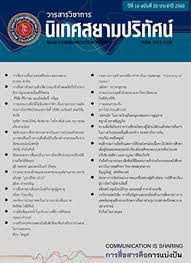The Use of Make-up Codes on Selected Ceremonial Contexts
Main Article Content
Abstract
The purpose of this article is to analyze the use of make-up codes on selected ceremonial contexts. To study how the code transfers the meaning on communication process, it was based on the concepts of Roman Jacobson’s communication model, semiology, co-text, intertexuality, simulation, and identity. According to the study, it was found that the code has changed and differed as these followings; 1.The Royal Ploughing Ceremonies In the ceremony, high-context communication is used. The context code is shown as “make-up code” to construct the meaning of the 4 beauty queens. 2. Thai traditional wedding ceremonies In case of wedding ceremony, Low-context communication is used. Make-code performes as context code for the constructed meaning of brides. 3. Official-private ceremonies Mid-level context communication is used in case of graduation ceremonies. The code is partially as context to express the constructed meaning of the ceremony entries. Keywords code, make-up, context, selected ceremony.
Article Details
References
เจริญพงศ์ ศรีสกุล. (2550). การออกแบบเนื้อหาส่วนควบและส่วนขยายในสื่อดีวีดีภาพยนตร์. (วิทยานิพนธ์มหาบัณฑิต จุฬาลงกรณ์มหาวิทยาลัย).
เจนจิรา เบญจพงศ์. (2554). สยามรัฐสัปดาห์วิจารณ์. ฉบับวันที่ 6-12 พฤษภาคม 2554.
แดน บีช บรัดเลย์. (2416). หนังสืออักขราภิธานศรับท์ Dictionary of Siamese language พ.ศ. 2416. กรุงเทพฯ: คุรุสภา.
ธเนศ เกษรสิริธร. (2555). การจัดการความรู้แหล่งเรียนรู้ กรณีพระราชนิเวศมฤคทายวันและสถานที่ศึกษาใกล้เคียง. (ปริญญาศิลปศาสตรมหาบัณฑิต บัณฑิตวิทยาลัย มหาวิทยาลัยศิลปากร)
เนตรทราย มณีโชติ. (2544). สมญานามในข่าวและรายการ กีฬาทางสื่อมวลชน. (วิทยานิพนธ์ปริญญามหาบัณฑิต จุฬาลงกรณ์มหาวิทยาลัย).
พึงพิศ เทพปฏิมา. (2546). การถ่ายทอดความคิดเรื่องจิตวิญญาณในภาพยนตร์. (วิทยานิพนธ์ปริญญามหาบัณฑิต จุฬาลงกรณ์มหาวิทยาลัย).
ไพลิน อนุเสถียร. (2551). การใช้ตัวละครเพื่อการสื่อความหมายในละครเบาสมองตามเหตุการณ์เรื่อง “เป็นต่อ. วิทยานิพนธ์ปริญญามหาบัณฑิต จุฬาลงกรณ์มหาวิทยาลัย).
รวิเทพ มุสิกะปาน. (2554). ผู้ทรงอิทธิพลแฟชั่นไทยร่วมสมัย. (ปริญญาศิลปศาสตรดุษฎีบัณฑิต มหาวิทยาลัยศรีนครินทรวิโรฒ).
ราชบัณฑิตยสถาน. (2546). พจนานกรม ฉบับราชบัณฑิตยสถาน พ.ศ. 2542. กรุงเทพฯ: นานมีบุคส์พับลิเคชั่น.
ศันสนีย์ วีระศิลป์ชัย. (2552). สี่แผ่นดิน กับเรื่องจริงในราชสำนักสยาม. พิมพ์ครั้งที่ 3. กรุงเทพฯ : มติชน.
สำนักงานการปฏิรูปที่ดินเพื่อเกษตรกรรม. (2559). วารสารสำนักงานการปฏิรูปที่ดินเพื่อเกษตรกรรม. ปีที่ 38 ฉบับที่ 8 เดือนพฤษภาคม 2559 : หน้าปก).
อภิญญา เฟื่องฟูสกุล. (2546). อัตลักษณ์: การทบทวนทฤษฎีและกรอบแนวคิด. กรุงเทพฯ: คณะกรรมการสภาวิจัย แห่งชาติ สาขาสังคมวิทยา.
อลงกรณ์ เทียมจันทร์. (2557). จิตรกรรมฝาผนังพระที่นั่งพุทไธสวรรย์. สำนักพิมพ์ กรมศิลปากร กระทรวงวัฒนธรรม. กรุงเทพฯ.
อุภาวัณณ์ นามหิรัญ. (2553). การวิเคราะห์พระบรมราโชวาทพระบาทสมเด็จพระเจ้าอยู่หัว ในพิธีพระราชทานปริญญาบัตร พ.ศ.2493-2542. (วิทยานิพนธ์ปริญญาอักษรศาสตรมหาบัณฑิต มหาวิทยาลัยศิลปากร).
ภาษาอังกฤษ
Baudrillard, Jean. (1983). The Precession of Simulacra. (Translated by Paul Foss, Paul Patton and Philip Beitchman), London : SAGE Publications Ltd.
Burton, G. (2002.) More Than Meets the Eye. (3rd ed.). London: Arnold.
John Fiske. (1990). Introduction to Communication Studies, London: Routledge.
McLuhan, M. (1964). Understanding Media : The Extensions of Man. New York: McGraw-Hill.


